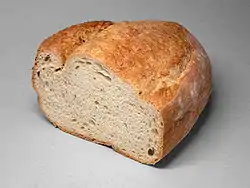Salt-rising bread
Salt-rising (or salt-risen) bread is a dense white bread that was widely made by early settlers in the Appalachian Mountains, leavened by naturally occurring Clostridium perfringens and other bacteria rather than by yeast.[1] Salt-rising bread is made from wheat flour; a starter consisting of either water or milk and corn,[2] potatoes,[3] or wheat; and minor ingredients such as salt and sugar.
.jpg.webp) | |
| Alternative names | Salt-risen bread |
|---|---|
| Type | Bread |
| Region or state | Appalachian Mountains |
| Main ingredients | Wheat flour, starter (water or milk; corn, potatoes, or wheat), bacteria (Clostridium perfringens) |
Salt in the name is a misnomer; the bread is not leavened by salt[2] nor does it taste salty.[4] One explanation for the name of the bread is that the starter was kept warm in a bed of heated salt.[2][4] Another possible origin of the name is the use of salt to inhibit yeast growth and provide an environment more conducive for the microbes to grow, enhancing the distinct flavors which predominate over the more typical yeast flavors.
Compared to a sourdough starter, salt-rising bread starter requires a shorter incubation period of 6–16 hours and a higher incubation temperature, ranging from 38–45 °C (100–113 °F).[2] Salt-rising bread is denser, with a closer grain, than yeast-leavened bread,[5] and has a distinctive taste and odor.[4] The pungent odor of the fermenting starter has been described as similar to "very ripe cheese".[2]
History
The exact origin of this bread is unknown, but evidence suggests that it was the pioneer women in early American states who discovered how to make bread this way. Commercial yeast was not available until the 1860s. Currently, the tradition of making salt-rising bread is kept alive by relatively few individuals and bakeries that tend to be clustered in the central to eastern United States. It is particularly popular in Kentucky, West Virginia, Western New York, and Western Pennsylvania.
Bacteria
One of the main rising agents, the bacterium Clostridium perfringens, is a common cause of food poisoning and can cause enteritis necroticans (pig-bel disease) and gas gangrene. Although disease-causing strains of C. perfringens have been isolated from salt-rising breads, there is no indication of salt-rising bread having ever caused any human disease. The baking process appears to reduce bacteria to safe levels.[1]
References
- Juckett, G; Bardwell, G; McClane, B; Brown, S (2008). "Microbiology of salt rising bread". The West Virginia Medical Journal. 104 (4): 26–7. PMID 18646681.
- Fertig, Judith (2011). Prairie Home Breads: 150 Splendid Recipes from America's Breadbasket. Houghton Mifflin Harcourt. pp. 78–79. ISBN 9781558321731.
- Lundy, Ronni (1994). Shuck Beans, Stack Cakes, and Honest Fried Chicken: The Heart and Soul of Southern Country Kitchens. Atlantic Monthly Press. p. 251. ISBN 9780871136008.
- Clayton, Bernard (2006). Bernard Clayton's New Complete Book of Breads. Simon and Schuster. p. 265. ISBN 9780743287098.
- Kohman, H.A. (6 October 1917). "Salt-rising bread: Raising dough with newly discovered bacteria". Scientific American Supplement. 84 (2179): 212–213. doi:10.1038/scientificamerican10061917-212supp. Retrieved 17 September 2016.
External links
- Brown, Susan Ray "The Salt Rising Bread Project "http://www.saltrisingbread.net/
- Greenwood, Darrell (August 3, 2010). "What is Salt Rising Bread?".
